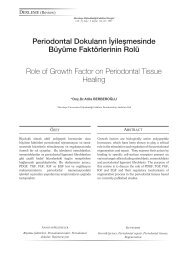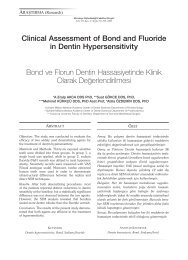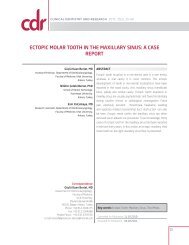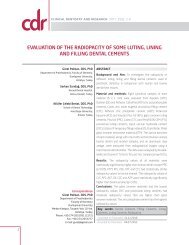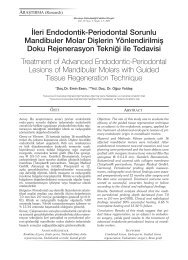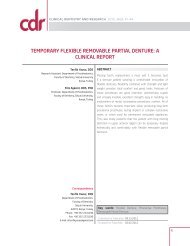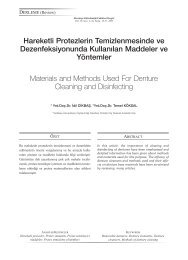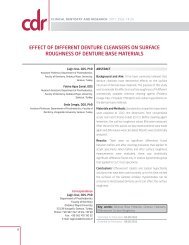African Type Burkitt's Lymphoma - dishekdergi.hacettepe.edu.tr
African Type Burkitt's Lymphoma - dishekdergi.hacettepe.edu.tr
African Type Burkitt's Lymphoma - dishekdergi.hacettepe.edu.tr
Create successful ePaper yourself
Turn your PDF publications into a flip-book with our unique Google optimized e-Paper software.
30<br />
In<strong>tr</strong>ODUCtIOn<br />
Burkitt’s lymphoma (BL) is an ex<strong>tr</strong>anodal<br />
malingnancy with distinct epidemiological, clinical,<br />
pathological, immunological, and molecular<br />
cytogenetic characteristics. 1 Burkitt’s lymphoma<br />
is a malignancy of B-lymphocyte origin that represents<br />
an undifferentiated lymphoma. During<br />
the 1950s, Dennis Burkitt described rapidly<br />
growing jaw and abdominal lymphoid tumors<br />
in East <s<strong>tr</strong>ong>African</s<strong>tr</strong>ong> children. 2 The Tumor, Burkitt’s<br />
lymphoma, is the human cancer most closely linked<br />
with a virus. Ebstein-Barr virus is associated<br />
with 90% of <s<strong>tr</strong>ong>African</s<strong>tr</strong>ong> patients with BL, but this<br />
percentage is considerably lower for BL seen in<br />
other parts of the world. The reason for the association<br />
between BL and Ebstein-Barr virus remains<br />
unknown. 1-3 The peak age of the <s<strong>tr</strong>ong>African</s<strong>tr</strong>ong><br />
BL is between 5 and 7 years. The male to female<br />
ratio ranges between 2:1 and 6,5:1 and is much<br />
higher in patients under 13 with an incidence of<br />
0,1 to 0,3/100,000. 4<br />
The clinical presentation of BL is characterized<br />
by rapid progression of symptoms with frequent<br />
multifocal ex<strong>tr</strong>anodular involvement, including<br />
cen<strong>tr</strong>al nervous system involvement. With<br />
in the oral cavity, this tumour can progress very<br />
fast and appears as a facial swelling or exophytic<br />
mass involving the jaws. 5 Involvement of facial<br />
bones and oral cavity occurs in less than 30% of<br />
cases in most series. 6-7 The <s<strong>tr</strong>ong>African</s<strong>tr</strong>ong> form of BL<br />
most frequently manifests itself as rapidly growing,<br />
ex<strong>tr</strong>anodal jaw tumors in young children,<br />
but it also may be first detected as an abdominal<br />
involving the kidneys or ovaries. The growth<br />
of the tumor mass may produced facial swelling<br />
and propitosis. Pain, tenderness, and paresthesia<br />
are usually minimal, although marked tooth<br />
mobility may be present because of aggressive<br />
des<strong>tr</strong>uction of the alveoler bone. 2<br />
The radiographic features are consistent with<br />
a malignant process and include a radiolucent<br />
des<strong>tr</strong>uction of the bone with ragged, ill-defined<br />
margins. This process may begin as several<br />
smaller sites, which eventually enlarge and coa-<br />
lesence. Patchy loss of the lamina dura has been<br />
mentioned as an early sign of BL.<br />
BL histopathologically represents an undifferantiated,<br />
small, noncleaved B-cell lymphoma.<br />
The lesional tissue invades as broad sheets of<br />
tumor cells and exhibits round nuclei with several<br />
prominent nucleoli and numerous mitoses.<br />
A classic starry-sky pattern is associated with<br />
lesional tissue, aphenomenon that is caused by<br />
the presence of macrophages within the tumor<br />
tissue. Tumors with a similar histomorphology,<br />
commonly referred to as American Burkitt’s<br />
lymphoma, have been observed in other coun<strong>tr</strong>ies<br />
where the neoplasms usually first detected as<br />
an abdominal mass. 1,2<br />
BL lesions have a dramatic response to chemotheraphy,<br />
particularly cyclophosphamide.<br />
The tumor also has been shown to be sensitive to<br />
metho<strong>tr</strong>exate, vincristine, and cytarabine. Combinations<br />
of drugs have achieved remissions in<br />
more than 90% of patients. Unfortunately, most<br />
experience recurrences and ultimately die of their<br />
disease. The prognosis for Burkitt’s lymphoma<br />
in the past was poor, with a median survival time<br />
of only 11 months. More recent <strong>tr</strong>ials with more<br />
intensive, multiagent chemotherapeutic protocols<br />
show a 68% remission rate after 38 months<br />
follow-up.<br />
In this case report we present of a 10-year-old<br />
male patient with Burkitt’s lenfoma from Turkey<br />
diagnosed by gingival overgrowth, alveoler bone<br />
loss, tooth mobility and histopathologically, <strong>tr</strong>eated<br />
by chemotherapy and followed up eighteen<br />
months post chemotherapy.<br />
Case rePOrt<br />
A ten year old boy presented with a six week<br />
history of painful and progressive swelling of the<br />
jaw bilaterally. It was considered as dental abcess<br />
at the local hospital and antibiotic therapy was<br />
considered for two weeks.The lesions of the gingiva<br />
and the swelling of the jaw did not resolve.<br />
He had also headache, fever and weight loss. A<br />
gingival biopsy was performed at the local hospi-





